Published
on 10
Nov 2020
|
All rights reserved.
|
|
|
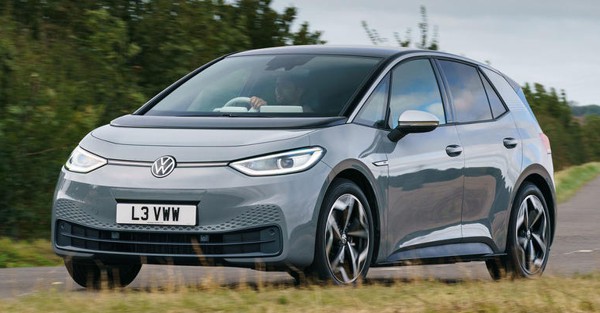
|
|
Not
quite the new Beetle or Golf, but the ID.3 is going to turn Volkswagen
into a EV leader by 2025.
|
|
Volkswagen compares the
launch of ID.3 to that of its legendary Beetle and Golf, implying how
important it sees the company entering the era of electric vehicles.
The ID.3 is not exactly the first electric VW, not even the first
affordable electric VW – that should be the e-Golf, produced since 2014
– but unlike all the previous attempts, it is built on a dedicated EV
platform called MEB (Modular Electric Matrix). This should bring
significant cost savings and take the company’s EV program into a new
stage. Some 33 billion euros will be invested into its EV program,
which includes ID.4 crossover and more variants for Skoda, Seat and
Audi. The Zwickau plant in Germany has been converted to build MEB cars
exclusively, and it has a capacity of 330,000 units a year. Then it
will be followed by the plants in China and USA. By 2025, the VW brand
alone will be producing 1.5 million electric cars annually, or 3
million units for the whole group. For comparison, Tesla targets to
deliver 500,000 cars this year. Among all the giant car makers,
Volkswagen group has the most ambitious EV plan. For an organization so
huge, especially a German one, you can’t help admiring the courage of
its CEO Herbert Diess.
While the plan is revolutionary, the car is not so. From technical
point of view, MEB has no innovation to speak of. It follows Tesla’s
approach to use a “skateboard” floorpan which houses all the battery
modules under a flat floor. This keeps center of gravity low and
contributes to structural strength as well. An AC induction motor is
placed at the rear axle and drives the rear wheels through a
single-speed transmission. It produces 204 horsepower and 229
pound-foot of torque, good enough to propel the mid-range ID.3 from
rest to 60 mph in just under 7 seconds and reach an
electronic-regulated 99 mph top speed. In other words, about the same
as Nissan Leaf or BMW i3. Unlike the revolutionary i3, its body
structure is made of steel to keep cost down, so the car weighs in
excess of 1700 kg.
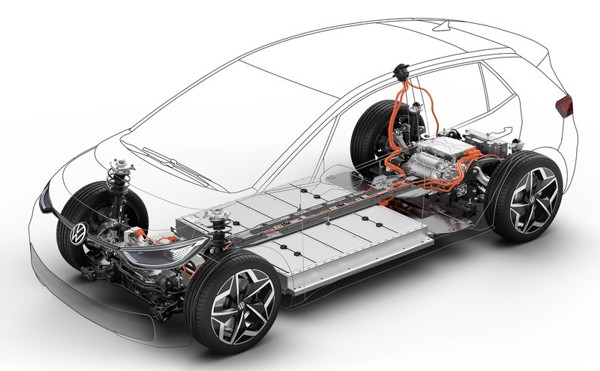
|
|
From
technical point of view, MEB has no innovation to speak of.
|
|
That’s for the mid-range model with 58 kWh battery. Two more battery
options are available: a base 45 kWh battery to realize the promise of
€30,000 entry level price, and a long-range model with 77 kWh battery.
Their ranges are 330, 420 and 550 km, respectively, or 205, 260 and 340
miles, measured under the more realistic WLTP cycles. The long-range
model is expected to top €50,000, not exactly a “People’s car” as we
hope for, and its 140 kg of extra weight extends 0-60 sprint by 0.6
seconds, accompanied with inevitable loss in handling agility.
However, being a Volkswagen its mechanical aspect is still more premium
than a Nissan Leaf. Rear-wheel drive aside, it rides on multi-link
suspension at the back, while electronic adaptive dampers are
available. You can opt for up to 20-inch wheels, but they won’t be too
wide, at 215mm the maximum in order to reduce friction and drag.
Speaking about drag, aerodynamics is a crucial area to improve energy
efficiency and extend its range. The ID.3 has an MPV-like silhouette,
with fast-angle windscreen and a teardrop rear spoiler. The front
grille is sealed, as is most area of the underbody. It achieves a Cd of
just 0.267, good for a hatchback. However, such an MPV shape looks
rather soulless to me. The nose of the car is almost characterless. The
sides look better, at least the thick C-pillar has some Golf in it, but
otherwise the ID.3 is just a safe design – not too conservative as some
VW cars, but not too distinctive or avantgarde either.
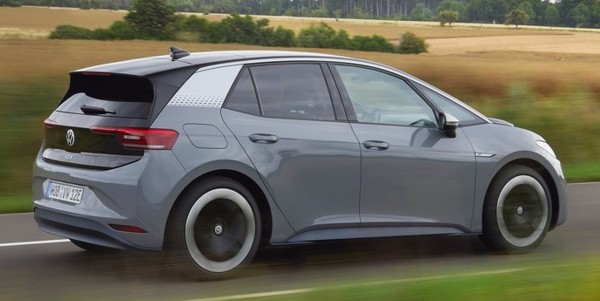 |
|
50:50
balance, rear-drive and typical Volkswagen dynamic qualities set it
apart from rivals like Nissan Leaf.
|
|
Clearly, the tallness of the car has some effect to its MPV looks.
Owing to the thick skateboard floorpan (no one can rival Tesla for
minimizing the floor height), the ID.3’s cabin is raised together with
its roof, which is 112 mm higher than that of a Golf. Otherwise, the
car has a similar footprint. It is 20 mm wider but 23 mm shorter than
its conventional sibling. Since there is no need to accommodate an
engine up front and exhaust system at the rear, its overhangs can be
massively shortened, resulting in a vast, 2771 mm wheelbase, or 135 mm
longer than Golf.
Inside, the sense of space is more obvious than that of Golf, thanks to
not least the forward placement of windscreen but also the vast glass
area, especially with panoramic roof. You sit high like a crossover and
have a commanding view on the road. It is not as spacious as a Passat,
but passengers on both rows enjoy generous head and leg room. At 385
liters, luggage space is slightly more than Golf, although access is
hampered by a high lip – the motor is mounted under the boot floor,
remember. The dashboard design is fashionable – minimalist, colourful
and very dependent on touchscreen to operate everything. Some physical
controls have been sacrificed to look “modern”, unfortunately at the
cost of convenience. More disappointing is the lack of typical
“Volkswagen quality”. For those used to soft touch plastics covering
almost every surface since Golf IV, they will be shocked to find out
most surfaces here are hard ones, including the shinny hard plastics on
the door panels. For a launch model costing considerably more than a
comparable Golf (the ID.3 launches in UK at £35,000 even after
the £3,000 government grant), its value for money is doubtful,
even with lower running costs considered. VW has already started the
downgrade of interior plastics (and lost of tactile switches, by the
way) in the latest Golf. The expensive batteries on ID.3 calls for even
more drastic measures to cut costs elsewhere. It also implies the
change of strategy under the leadership of Diess – the group has
finally left the influence of Ferdinand Piech.
 |
|
For
those used to soft touch plastics covering almost every surface since
Golf IV, they will be shocked to find out most surfaces here are hard
ones...
|
|
In terms of usability, the ID.3’s interior should be good enough,
although some software glitches hamper the response of its infotainment
system on early cars, and some functions are disabled before problems
are to be fixed, which will be updated over the air. The digital
instrument is a nice touch, as it is fixed to the steering column and
adjust together with the steering wheel.
On the move, the ID.3 does not set any new standards, but it is matured
enough for Golf buyers to consider switching to EVs. As in most
electric cars, performance feels unusually strong, stronger than
figures suggested, while refinement is excellent when driving in town,
with little mechanical noise generated from the powertrain. At motorway
speeds, it suppresses road and wind noise better than most rivals,
worthy of the VW badge. The structure feels sturdy, too,
noticeably more so than Nissan Leaf. The ride is more refined, hampered
by only sharp bumps.
Despite the tremendous weight to carry, the ride and handling balance
is well judged. Due to the high sitting position, the roll in corner is
more pronounced, but the car corners fluently with a stable and
predictable manner. 50:50 weight distribution gifts it a good chassis
balance, and the rear-wheel drive allows better traction out of corner
and no corruption of steering feel under power. The steering actually
lacks feel, but it is otherwise precise and linearly weighted. Back
into town, its remarkably short turning circle – made possible by
lacking an engine up front - allows the ID.3 to steer and park easily
on narrow streets.
As a relatively affordable EV, the ID.3 is hard to fault. It is better
than its rivals from Nissan and Renault, unquestionably, thus is
Europe’s best affordable EV to date. However, it does not break any new
ground like Tesla Model 3, and its value for money is still no match
for a Golf, which is just as usable, but is significantly cheaper to
buy (if not to run) yet feels more premium in build quality. The big
time for EV is finally coming, but that is mainly driven by policy
rather than the development of technology. Yes, charging still takes a
life. Even if you can find a 100kWh charging station empty, it will
take half an hour to charge to 80 percent full. We should have been
waiting for solid state battery to revolutionize the world, but our
planet and our governments run out of patience.
|
Verdict:    |
Published
on 29
Oct 2021
|
All rights reserved.
|
|
Cupra Born
|
|
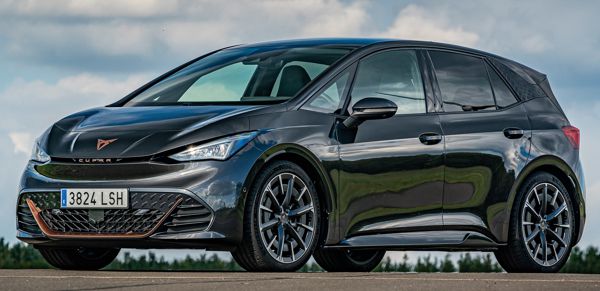
|
|
More
a reskinned ID.3 than a dedicated product, though that skin looks more
stylish.
|
|
When
Volkswagen group was overseen by Ferdinand Piech, it launched the
biggest platform sharing in the industry, PQ34. This gave birth to Golf
Mk4, Bora, New Beetle, the first generation Audi A3, TT, Seat Leon,
Skoda Octavia and the second generation Seat Toledo. Over the years,
Volkswagen refined its platform sharing strategy, making the platforms
modular, flexible in sizes and powertrains. This allowed cars to
differentiate, giving them different style, functions and
personalities. It became a model that many others copy today.
However, when it comes to electrifying its cars, the platform sharing
strategy seems to take a backward step. Perhaps because the current
boss Herbert Diess spent his entire career in production and supply
chain management instead of product development, he chases economy of
scale harder than ever. To offset the high cost of battery, he needs to
build 15 million cars on the MEB platform that underpins ID.3. And
that’s just the first wave of products. While the old strategy gave
brands and models sufficient unique parts and variations to
differentiate them, the MEB cars seem to have far higher commonality.
Cupra Born is an example.

|
|
Slightly
quicker and sportier, but it shares the ID.3 numb steering and soft
brake pedal.
|
|
At the first glance, the Cupra Born looks far more stylish than its VW
sibling ID.3. In fact, the car is a reskinned ID.3. Not just the
floorpan, the monocoque is also carried over intact. Ditto all the
glass, doors and roof. The clever designers at Seat/Cupra gave it a
sportier nose and tail, adds tasteful bronze detailing, sporty wheels
up to 20-inch and stylish graphics at the C-pillars. Well done. I think
it is the prettiest MEB cars to date, but you are still aware of its
roots, because you won’t confuse the ID.3’s tall and monospace shape
with other cars.
Inside, the Spanish brand again gives it a smarter look and feel.
Although equipment like instrument and touchscreen infotainment system
are shared, the Cupra does enjoy different dashboard and transmission
tunnel moldings as well as softer trims made of recycled materials.
Bronze accents lend it a more tasteful look. The seating position and
space are familiar though. You sit higher on the raised floor. The rear
passengers sit higher still, so headroom is not quite as generous as a
1540mm-tall car should have been.

|
|
The
interior gets tasteful bronze accents and softer recycled materials.
|
|
Cupra is supposed
to be a sporty premium brand, so although the Born shares the same
hardware with ID.3, including 3 battery sizes (45, 58 and 77kWh),
rear-mounted motor (either 150hp or 204hp), suspension (struts and
multi-link) and a rather slow charging rate of 125kW, it adds an
e-boost option which can lift the output of the 204hp motor to 231hp
for up to 30 seconds, cutting 0-60 mph by 0.6 second. It feels quick,
but that sensation fades quickly as well once you are arriving highway
speed. Top speed is only 99 mph.
Brilliantly, even though it rides on lower profile tires of 215/45R20
and has its ride height dropped by 10-15mm, the ride remains very good,
smooth and quiet. Optional adaptive dampers lend it respectable body
control, while 50:50 weight distribution gives it a neutral handling.
Nevertheless, the car is not as sporty as you would expect for
something wearing the Cupra brand. The steering is lifeless (sport mode
and Cupra mode add weight without more feel). The brake pedal feels
soft. The handling attitude does not change according to throttle. When
you push it to the limit, it just gives up, refusing to rotate. A safe
and obedient car it certainly is, but not very playful.
If these characteristics are familiar, it is because ID.3 shares them.
The Cupra is a tad better to drive and better to look, but
fundamentally it is in the same ballpark of the Volkswagen. If you look
for a ground-breaking electric car, the Korean duo of Hyundai Ioniq 5
and Kia EV6 are clearly better options.
|
Verdict:    |
Published
on 23
May 2024
|
All rights reserved.
|
|
Cupra Born VZ
|
|

|
|
The
best MEB car to date, and the closest thing to an electric version of
Golf GTI.
|
|
An
electric hot hatch can be fun to drive or even exciting, as proved by
Hyundai Ioniq 5 N, but until now Volkswagen group fails to crack the
codes. Its GTX badge, supposed to be the electric equivalent to GTI,
has been sales flop because of overweight (due partly to twin-motor),
lack
of power and simply uninteresting handling. Surprisingly, the first
recommendable MEB platform-based hot hatch
does not come from the Volkswagen ID series but their sister car Cupra
Born. While the standard Born is just a slight improvement over ID.3,
the new Born VZ is a much sizable upgrade. Power comes from the new
APP550 motor that has been used on the ID.7 large car, but its output
is
lifted further to 326 hp, some 95 hp more than the standard Born.
Moreover, its 402 pound-foot of torque is almost doubled. There is no
front motor, so all these horsepower and torque are sent to the
rear axle, pretty much like an old BMW M140i. However,
since the electric hot hatch tips the scale at over 1900 kg, its 0-60
mph time of 5.4 seconds is not particularly impressive. Top speed is
lifted significantly from the
usual 99 mph, but still no better than 124 mph or 200 kilometers per
hour. For comparison, the current Golf GTI is good for 155 mph and 0-60
in 5.6 seconds.
Outside, the VZ is hard to distinguish from the standard car except a
set of new-look wheels (still 20-inch) and badges. Never mind, as the
Born has always been quite stylish, if a little like MPV in shape.
Inside, Sabelt bucket seat holds you tight and places you lower.
There is a larger touchscreen which runs the latest evolution of
software,
a new steering wheel and column-mounted paddles for adjusting
regenerative braking. The battery underneath your seat of the pants has
grown slightly from 77 to 79kWh net capacity. In addition to improved
battery management, the car is good for a remarkable range of up to 600
km (372 miles). In the real world, expect 80 percent of that
achievable.
The new motor feels punchy in the real world, too, suggesting the 0-60
mph time could be on the conservative side. However, the acceleration
tails off quickly in EV fashion, so it is not quite as rewarding to
push as conventional hot hatches on open road. In the twisty, the extra
torque is proved very useful, putting the car’s enhanced grip (rear
tires widened to 235mm), retuned steering, lowered suspension (by 10mm
front and 15mm rear) and stiffer anti-roll bars to good use. It
displays good roadholding and stability. The steering is light yet
precise and not too numb. There is plenty of front-end grip but the
turn-in is never nervous, despite the car’s rear-biased weight
distribution and power. Turn the stability control to the sportiest
mode (it cannot be switched off completely) and you may even balance
the car on throttle, thanks to the sharper throttle response in the
motor mapping and the extra shove from the bigger motor. Oversteer is
available for access at only low speed if you try deliberately, but
overall the car’s stability control won’t allow excessive movements. It
is fun to drive, if not as much as the lighter Golf GTI.
Having said that, the VZ is still a very heavy car. This might put its
chassis to bigger tests when the road gets bumpier and more
challenging. The new DCC Pro adaptive dampers it employs, which adjust
both compression and rebound rates, help tying down the car to some
extent, but a Golf GTI doesn’t really need those dampers to excel.
Moreover, the
VZ’s driver appeal is somewhat hampered by its non-linear brake pedal,
a rather common weakness for electric cars. As it fails to blend
regenerative braking and mechanical braking seamlessly, the first part
of pedal travel feels dead. Besides, it needs to fit a more powerful
set of brakes.
Anyway, the Born VZ is currently the best middle-ground hot hatch (i.e.
Golf GTI equivalents) in electric form. It offers the performance and
handling you would expect while delivering them in a reasonably
engaging way. In comfort mode, it drives as easy and refined as a
regular Born or any electric cars. It is spacious, rather well priced
at around £45,000, offers a long range while 175 kW charging
speed (10-80% charge takes 30min) is competitive in its class. In
short, it is
the best MEB car to date.
|
Verdict:    |
Published
on 10
Jan 2025
|
All rights reserved.
|
|
ID.3 GTX
|
|
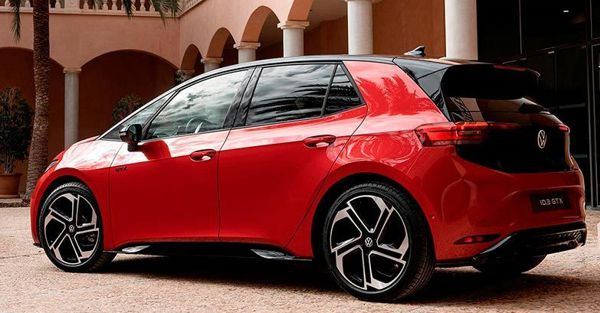
|
|
Supposed
to be the equivalent of GTI, but fails to deliver that promise.
|
|
This
is basically Volkswagen’s version of Cupra Born VZ. It shares the same
performance goodies with the Spanish car: the 326-horsepower AP550
motor that drives the rear wheels only; a larger, 79kWh battery that
gives a remarkable 369 miles (594km) of range; standard adaptive
dampers and tuned suspension. 0-60 mph sprint takes 5.4 seconds,
slightly quicker than a Golf GTI but slower than Golf R. Top speed is
lifted from the lesser car’s 99 mph to 124 mph, not quite a match to
conventional cars. Weight increases to nearly 2 tons, certainly raising
eyebrows to those expecting GTI kind of agility in corners. How does it
behave in the real world?
Well, a bit disappointing. First of all, the straight line performance
is below par for a hatchback costing £46,000 to buy. While 5.4
seconds is by no means slow in conventional sense, it is more about
linear acceleration, without the drama and sound delivered by a proper
petrol engine. The lack of gearchange makes the driving experience
boring, too.
You might say the same to its Spanish cousin, but the Born VZ has some
extra features, like the a drive mode button on the steering wheel,
whereas the Volkswagen makes do with the touchscreen menus. The Cupra's
Sabelt bucket seats are also sportier than Volkswagen's touring
buckets. More important, Volkswagen’s chassis tuning is more subtle,
biased towards the safe side. Stability control cuts in early to kill
the slightest oversteer, rendering the rear-drive hardware to useless.
The Cupra offers a wider scope of throttle steer, so it is more
engaging and playful to drive. Ultimately, both cars feel tall and
heavy at the limit, but the Volkswagen gives up way before that. As a
daily car, the ID.3 GTX offers plenty of grip and a generally good ride
comfort with its adaptive dampers, but it fails to work as the
equivalent of GTI, so why would you pay so much for less?
|
Verdict:   |
|